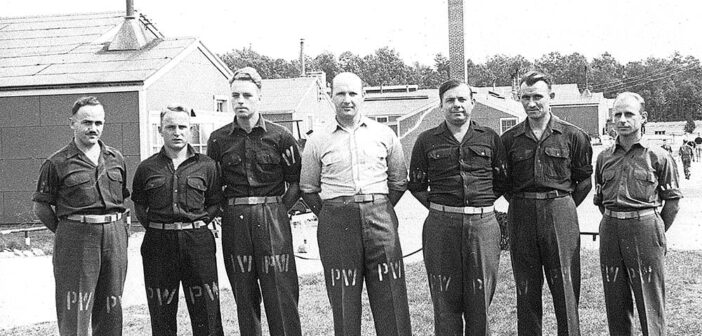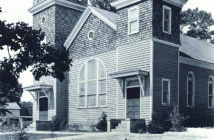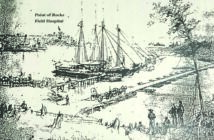“We had a pretty good snow storm and we thought we would have a little fun with the German prisoners. We made up snowballs and started throwing them at [the POWs],” said Billy Stubbs, a Bensley resident who remembers the German prisoners once housed adjacent to what is now Defense Logistic Agency, formerly DSCR. “They responded pretty lively and started throwing them back,” he said. Stubbs relates that when the German officer in charge spotted them, he responded pretty well, too. “He didn’t think it was very funny and reprimanded us, saying, ‘This is not how we treat our prisoners.’ Stubbs said. But he conceded, saying it was pretty much fun, and several of the POWs were laughing along with them.
It was an early snow in the autumn of 1945, and Stubbs had just been discharged from the service. Waiting for a chance to enroll at the University of Richmond, he picked up a labor job at what was then called the Richmond Depot.
World War II was over by the time the German POWs and Americans were fighting with snowballs instead of rifles and bombs. Hitler had committed suicide in April, and Allied victory (V-E Day) was declared on May 8. The atomic bombs had been dropped in Japan and the Japanese had surrendered in August. The German POWs behind barbed wire at Bellwood must have been waiting to go home.
Many prisoners had arrived in the spring of 1945 before V-E Day. Initially, 200 German captives were brought to Bellwood by rail to build the prison camp. The population quickly grew to 1,200, and preparations were underway for an additional 2,700 enemy soldiers. By late 1945, over half a million German, Italian, and Japanese combatants were held in the United States.
According to Stephen Baker, public affairs specialist of DSCR, the camp was formed after Europe, especially England, became overwhelmed with the number of prisoners it was holding. At the same time, the Richmond ADF Depot at Bellwood was experiencing a serious decline in its work force. The number of civilian workers diminished from 5,200 workers to 3,500 in just 14 short months.
The camp was enclosed by barbed wire, with enough lighting for the soldiers to keep an accurate eye on the prisoners. The compound was guarded by American soldiers – many of whom were veterans of battles against the German army – as well as 130 Bellwood Auxiliary Military Police (MP). These soldiers had fought in foreign battles, watching those close to them fall from the line of duty. Therefore, even though discipline was not frequently needed, they were prepared to do whatever was needed at any sudden moment.
The 50-acre camp was located between Conifer Road and the CSX rail line that runs adjacent to DSCR. Unless you lived nearby, you may not have known the woods were concealing German POWs.
A March 25, 1945 article in the Richmond Times-Dispatch reported: “Despite some presuppositions about POW camps, the prisoners at this camp were not treated severely or unfairly. The U.S. soldiers treated each German prisoner by the regulations of the Geneva Convention of 1929. They were given food to eat, and although they were never fed an abundant feast, they did fill their stomachs. Prisoners were expected to do their own housekeeping and received no help except for what they could do with their own hands.”
Stubbs says most of the Germans didn’t speak English and went about their daily work. He doesn’t remember seeing too many armed guards, just the supervisor in charge.
“I guess if any of them got away, they wouldn’t get too far because most didn’t speak any English,” says Stubbs. “However, there was one German who tended the flower beds. He was a dyed-in-the-wool Hitler man.”
Stubbs said the gardener liked to talk Nazi politics, but the other POWs never mentioned Hitler’s name.
These German soldiers held some special skills that they practiced while in industrialized Germany. Some were machinists, mechanics, and tool workers, which were all skills that were needed for work at the Richmond Depot. The prisoners were required to work eight-hour days, six days a week in order to earn any money. Their earnings totaled to 80 cents per day. Not every soldier agreed to work at first, but once they came to terms that they were in need of money, all in the form of canteen checks instead of cash, they picked their feet up and headed to work.
In 2003, Robert Partin, now deceased, wrote in the Village News that his father R.B. Partin had hired German prisoners from the camp at Bellwood to help at harvest time. His father planted hay, corn, and wheat on a farm where Thomas Dale High School now stands.
“Every morning my dad would go to Bellwood to pick up the men, twelve young men for the farming and two to help Mom in the kitchen,” wrote Partin. “The first day these men came, their lunch consisted of one piece of dark bread and a piece of fatback. My mother found out what they had to eat and said, ‘no more.’ She and the two Germans who helped her in the kitchen fixed dinner for everybody. She also provided each of the men with a goodie bag when they went back to camp.”
Many of the POWs were shipped back to Germany in early 1946 and repatriated, but a number of them stayed in the United States after the war and became naturalized as U.S. citizens.




